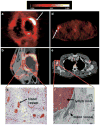Positron emission tomography tracers for imaging angiogenesis
- PMID: 20559632
- PMCID: PMC3629959
- DOI: 10.1007/s00259-010-1503-4
Positron emission tomography tracers for imaging angiogenesis
Abstract
Position emission tomography imaging of angiogenesis may provide non-invasive insights into the corresponding molecular processes and may be applied for individualized treatment planning of antiangiogenic therapies. At the moment, most strategies are focusing on the development of radiolabelled proteins and antibody formats targeting VEGF and its receptor or the ED-B domain of a fibronectin isoform as well as radiolabelled matrix metalloproteinase inhibitors or alpha(v)beta(3) integrin antagonists. Great efforts are being made to develop suitable tracers for different target structures. All of the major strategies focusing on the development of radiolabelled compounds for use with positron emission tomography are summarized in this review. However, because the most intensive work is concentrated on the development of radiolabelled RGD peptides for imaging alpha(v)beta(3) expression, which has successfully made its way from bench to bedside, these developments are especially emphasized.
Conflict of interest statement
Figures







Similar articles
-
Radiolabelled RGD peptides for imaging and therapy.Eur J Nucl Med Mol Imaging. 2012 Feb;39 Suppl 1:S126-38. doi: 10.1007/s00259-011-2028-1. Eur J Nucl Med Mol Imaging. 2012. PMID: 22388629 Review.
-
Radiolabeled tracers for imaging of tumor angiogenesis and evaluation of anti-angiogenic therapies.Curr Pharm Des. 2004;10(13):1439-55. doi: 10.2174/1381612043384745. Curr Pharm Des. 2004. PMID: 15134568 Review.
-
Radiotracer-based strategies to image angiogenesis.Q J Nucl Med. 2003 Sep;47(3):189-99. Q J Nucl Med. 2003. PMID: 12897710 Review.
-
Radiolabeled RGD peptides as integrin alpha(v)beta3-targeted PET tracers.Curr Med Chem. 2012;19(20):3301-9. doi: 10.2174/092986712801215937. Curr Med Chem. 2012. PMID: 22664242 Review.
-
Alphavbeta3-integrin imaging: a new approach to characterise angiogenesis?Eur J Nucl Med Mol Imaging. 2006 Jul;33 Suppl 1:54-63. doi: 10.1007/s00259-006-0136-0. Eur J Nucl Med Mol Imaging. 2006. PMID: 16791598 Review.
Cited by
-
Accumulation of nano-sized particles in a murine model of angiogenesis.Biochem Biophys Res Commun. 2014 Jan 10;443(2):470-6. doi: 10.1016/j.bbrc.2013.11.127. Epub 2013 Dec 7. Biochem Biophys Res Commun. 2014. PMID: 24321551 Free PMC article.
-
In Vivo Anchoring Bis-Pyrene Probe for Molecular Imaging of Early Gastric Cancer by Endoscopic Techniques.Adv Sci (Weinh). 2023 Feb;10(4):e2203918. doi: 10.1002/advs.202203918. Epub 2022 Nov 27. Adv Sci (Weinh). 2023. PMID: 36437107 Free PMC article.
-
The Role of VEGF Receptors as Molecular Target in Nuclear Medicine for Cancer Diagnosis and Combination Therapy.Cancers (Basel). 2021 Mar 3;13(5):1072. doi: 10.3390/cancers13051072. Cancers (Basel). 2021. PMID: 33802353 Free PMC article. Review.
-
Engineered knottin peptide enables noninvasive optical imaging of intracranial medulloblastoma.Proc Natl Acad Sci U S A. 2013 Sep 3;110(36):14598-603. doi: 10.1073/pnas.1311333110. Epub 2013 Aug 15. Proc Natl Acad Sci U S A. 2013. PMID: 23950221 Free PMC article.
-
[(18)F]FPRGD2 PET/CT imaging of integrin αvβ3 levels in patients with locally advanced rectal carcinoma.Eur J Nucl Med Mol Imaging. 2016 Apr;43(4):654-62. doi: 10.1007/s00259-015-3219-y. Epub 2015 Oct 22. Eur J Nucl Med Mol Imaging. 2016. PMID: 26490751
References
-
- Creamer D, Sullivan D, Bicknell R, Barker J. Angiogenesis in psoriasis. Angiogenesis. 2002;5:231–6. - PubMed
-
- Bishop GG, McPherson JA, Sanders JM, Hesselbacher SE, Feldman MJ, McNamara CA, et al. Selective alpha(v)beta(3)-receptor blockade reduces macrophage infiltration and restenosis after balloon angioplasty in the atherosclerotic rabbit. Circulation. 2001;103:1906–11. - PubMed
-
- Chavakis E, Riecke B, Lin J, Linn T, Bretzel RG, Preissner KT, et al. Kinetics of integrin expression in the mouse model of proliferative retinopathy and success of secondary intervention with cyclic RGD peptides. Diabetologia. 2002;45:262–7. - PubMed
-
- Folkman J. Role of angiogenesis in tumor growth and metastasis. Semin Oncol. 2002;29(6 Suppl 16):15–8. - PubMed
Publication types
MeSH terms
Substances
Grants and funding
LinkOut - more resources
Full Text Sources
Other Literature Sources

